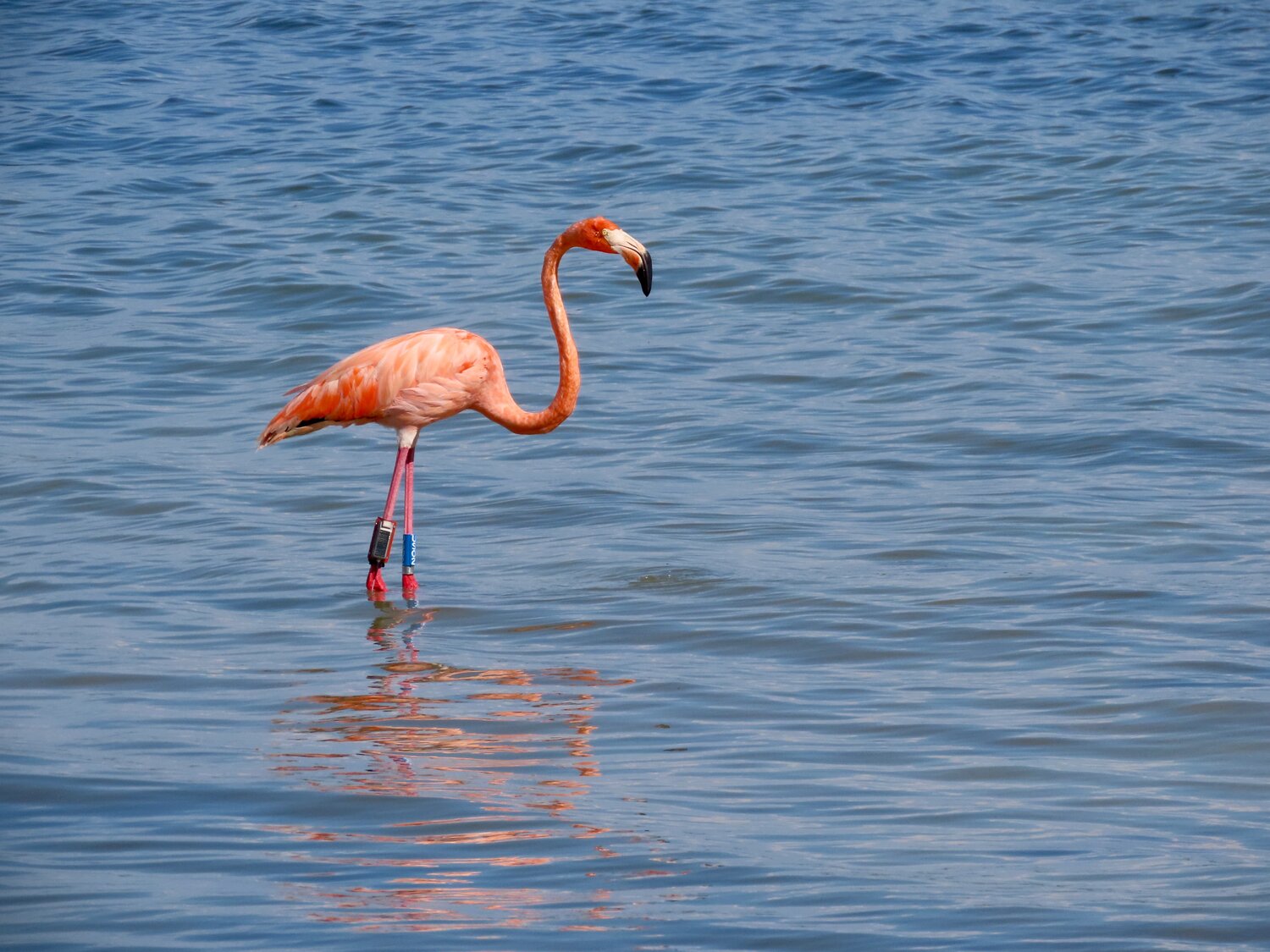Hurricane Idalia’s Category 3 landfall brought rain, wind, and, unexpectedly, flamingos...
Join our family of readers for as little as $5 per month and support local, unbiased journalism.
Already have an account? Log in to continue. Otherwise, follow the link below to join.
Please log in to continue |

In late August, Hurricane Idalia’s Category 3 landfall brought rain, wind, and, unexpectedly, flamingos to Florida. While many flamingos have been reported on Florida’s shores, one bird was rescued from the Gulf and rehabilitated by the Seaside Seabird Sanctuary. Prior to its successful release in Pinellas County on Saturday, Audubon Florida research staff tagged the bird with a geolocator that could provide scientists with important clues about the movements and fates of these storm-blown birds.
American Flamingos were more common in Florida before they were hunted to extirpation around 1900. Today, they are numerous in Mexico and Cuba where they breed, with a few individuals straying to the Everglades and Florida Bay in winter. As Hurricane Idalia passed between the Yucatan and Western Cuba this August, her strong winds likely swept up flamingos from this region, carrying them to Florida’s coast. Sightings have been reported on beaches and in other Florida natural areas including in the Keys, Tigertail Beach, Sanibel Causeway, Bunche Beach, Punta Gorda, Charlotte Harbor, Clearwater, Treasure Island, Siesta Key, Tarpon Springs, Port St. Joe, St. Marks National Wildlife Refuge, and Lake Pithlachoco, as well as locations in Ohio, North Carolina, South Carolina, Virginia, Kentucky, Texas, Tennessee, Alabama, and more.
The rehabilitated flamingo, affectionately known as “Peaches,” was rescued floating in the Gulf off St. Pete Beach by boaters. Society for the Prevention of Cruelty to Animals Tampa Bay transferred it to the Seaside Seabird Sanctuary in Indian Shores, where hospital staff determined the bird was in good condition overall but was visibly exhausted, likely from its hurricane ordeal. After a day of rest and supportive care, the bird began self-feeding, and by week’s end, “Peaches” became much more active and vocal.
Audubon Florida’s Director of Research Jerry Lorenz, PhD, recognized that Peaches represented a golden opportunity to learn more about wild flamingos and their movements in Florida. The USGS Bird Banding Laboratory agreed and rushed its federal approval for Lorenz and ZooMiami’s Frank Ridgley, DVM, to tag Peaches with bands and a satellite transmitter before its return to the wild. The flamingo will now be part of a unique study of flamingo movements between breeding grounds and Florida.
This isn’t the first time a rescued flamingo has provided insight into the mystery of their return to Florida. In 2015, Dr. Lorenz worked with Steven Whitfield, PhD, and other members of the Florida Flamingo Working Group to affix a tracking device to a young American Flamingo captured at the Naval Air Station at Boca Chica Key, Florida. The study tracked the bird, dubbed “Conchy,” for nearly two years and reported on the bird’s whereabouts before the tracking device stopped transmitting signals. The study revealed the flamingo’s preferred habitats and locations (mangrove-fringed islands and mudflats at Snake Bight in Everglades National Park) and upended the prevailing wisdom by not leaving Florida as many anticipated it would.
With its new tracking device, Tampa Bay’s “Peaches” will add critical data to this research initiative. Will the flamingos brought to our shores remain and breed here? If they return to the Yucatan and Cuba, will they return in subsequent years? Florida once had breeding flamingos year-round. Might we again one day, with the protection and restoration of key habitat, including coastal wetlands, the Everglades and Florida Bay?
On Sept. 9, the Seaside Seabird Sanctuary team released “Peaches” at Fort DeSoto Park, where other flamingos have been consistently seen since Hurricane Idalia. The public is asked to give this and all flamingos in Florida space to rest and feed undisturbed. Photographers and other enthusiasts approaching too closely present a grave threat to their survival.
“We want these flamingos to stay and raise their families here,” says Dr. Lorenz. “If we give them their space, restore their habitat, and keep their water clean, we can hope for a pink future in Florida.”
Want to learn more about American Flamingos in Florida? Join us at 6 p.m. ET on Wednesday, Sept. 13, for a live webinar with Dr. Jerry Lorenz. Register here: act.audubon.org/a/flamingos
Audubon protects birds and the places they need, today and in the future. Audubon works throughout the Americas using science, advocacy, education, and on-the-ground conservation. State programs, nature centers, chapters, and partners give Audubon an unparalleled wingspan that reaches millions of people each year to inform, inspire, and unite diverse communities in conservation action. A nonprofit conservation organization since 1900, Audubon believes in a world in which people and wildlife thrive.